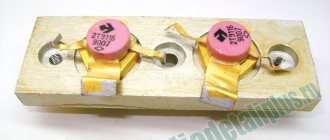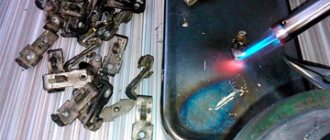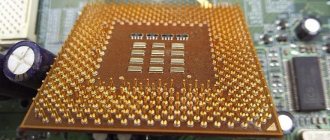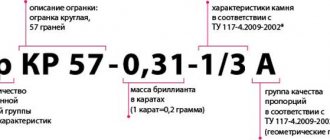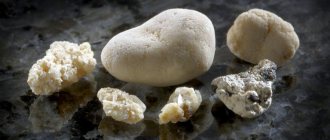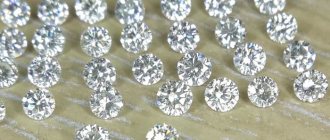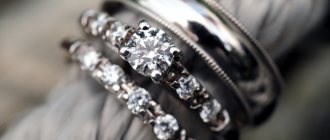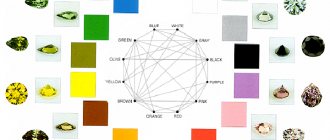The Paris International Exhibition of 1925 introduced the world to advances in science and the decorative arts. Their bold combination appealed to modern fashionistas and fashionistas, and scientific and technological progress has since begun to have a significant impact on jewelry production. Refining as a method of obtaining high-purity precious metals today allows jewelry to meet all international standards.
Some concepts and definitions
The terms “affinage” and “refining” come from the French verb affiner (to purify) and describe in metallurgy the sequence of technological processes for obtaining precious metals of high purity. It is known that the popular 585 gold has only 58.5% of the noble source, and the rest is additives that give jewelry samples the necessary qualities (strength, weight, color).
Refining precious metals involves purifying everything unnecessary. Various methods of targeted physical and chemical influence make it possible not only to separate substances, but also to remove contaminants from the composition. The raw materials for refining are various materials:
- jewelry or technological scrap,
- gold-containing concentrates from mines,
- grains of native schlich gold,
- sludge from electrolysis coating shops of zinc and silver, nickel and copper,
- silver foam from metallurgical lead production plants.
The preparation of any raw material consists of crushing, roasting and fusion. For example, radio-electronic parts are first dismantled and the housing and switching part, which does not contain precious metals, are separated. This allows you to reduce the number of environmental problems during processing and obtain a gold purity of up to 996.5 (99.65%), and silver – up to 999 (99.90%).
All technologies can be roughly divided into three conditional groups:
- Wet. They are based on chemical transformations.
- Dry ones that use chlorine vapor treatment.
- Electrolysis in special baths.
Some methods require expensive equipment and technology and are applicable only in specialized metallurgical enterprises, while others are quite easily performed by craftsmen. Chemical refining is suitable for both a jewelry workshop and a home laboratory, but in the latter case, work cannot be started without a fume hood and the use of personal protective equipment. Among the instruments and chemical utensils you will definitely need to purchase:
- crucible for heating, roasting, burning or melting materials over an open fire,
- durable tweezers,
- steel knitting needle,
- heat-resistant glass flask,
- electric stove for heating solutions,
- burner for melting metals,
- Filtration equipment: container, gauze, paper.
To read: How much are 5 rubles of 1901 Nicholas II worth today + what does the price of a gold coin depend on
In industry, a “dry” method is used for refining gold and silver: contaminated melts are treated with chlorine, and volatile reaction products (impurity chlorides) are captured by special equipment.
Electrolysis is widely used, when the purified substance is collected at the cathode, and purification by cupellation, based on the properties of lead to react with oxygen in the air, and then evaporate and deposit on the walls of the furnace.
Chemical purification of gold
For many centuries, gold has served as a symbol of success and a universal payment agent. Traditional sources (mining and sand washing) do not always provide the required purity grade, and sometimes gold is literally lying under your feet, and you can get it without leaving your apartment. There are two main methods for separating gold from impurities. The first is chemical , used in jewelry workshops and by craftsmen who extract precious metals from parts of electrical contacts, semiconductor microcircuits and parts of television and radio equipment.
First, using a magnet, inclusions containing iron are separated from the total mass, since the processing of such raw materials occurs according to different standards. If this cannot be done, then the metallic iron is removed by treating the scrap with concentrated sulfuric or hydrochloric acids. The mixture of gold compounds with copper, zinc, tin and silver remaining after deferrization is dissolved when heated in nitric acid with a concentration of 30 to 40%.
An indicator of the end of the reaction is the cessation of the release of nitrogen dioxide when a new portion of acid is added. After this, a saturated solution of sodium chloride (ordinary table salt) is added to the mixture, causing the precipitation of silver chloride. The gold-bearing sediment separated during decantation is poured with concentrated hydrochloric acid at a ratio of 1:20. The mixture is heated and boiled, and nitric acid is added drop by drop until nitrogen oxides stop being released.
Evaporation with additions of hydrochloric acid is performed 3 times, then filtered, the dry residue is poured with a saturated solution of ferrous sulfate, and the mixture is allowed to warm up. Gold is released in the form of scaly particles of a reddish-brown color, which are filtered, washed and boiled in another portion of nitric acid to remove traces of impurities. The residue is filtered, washed abundantly with water and dried. The resulting gold dust is fused with sodium nitrate (sodium nitrate) and borax (sodium tetraborate), such ingots are called “king” and contain 99.95% pure gold.
To read: How much are silver 15 kopecks from 1900 worth today: price table depending on condition
Electrolysis and Miller's method
The second method of refining gold is electrolytic , it is used by large production facilities with large volumes of processing. The anode for electrolysis is purified gold weighing up to 2 kg, and the cathode is gold tin with a thickness of 0.1 to 0.25 mm, made of pure metal by rolling and grooved for rigidity on a special press.
The reaction occurs in a mixture of solutions of hydrochloric acid and gold chloride, for which small porcelain or vinyl plastic baths with a capacity of 20 to 65 liters are used. They are installed in water baths, which allows maintaining the electrolyte temperature from 50 to 60 °C. The solution is mixed with compressed air using the bubbling method, and the chlorine released during the reaction is removed by extraction. Gold is deposited on the cathode in the form of a shiny film, the speed of the process depends on the current density used.
Another industrial refining method is the Miller method , which uses poisonous chlorine gas. It is used if it is necessary to remove silver from gold alloys and to obtain gold from materials of natural or artificial origin that have a low percentage of precious metal content. When treated with chlorine vapor, crushed raw materials containing a large amount of foreign impurities are first separated by metals that have weaker oxidizing abilities.
First, zinc and iron enter the chlorination reaction, then antimony and tin, then copper and lead. Last on this list are silver and gold. The advantage of the method is the absence of other chemical reagents other than chlorine, and the small dimensions of the reactor (from 1.0 to 1.5 m).
A significant drawback is the high risk of poisoning from the resulting volatile compounds. For example, mercuric chloride (mercuric chloride) is a dangerous neurotoxin that accumulates in the human body, is not excreted and slowly kills it.
How profitable are investments in refined precious metals?
Refined precious metals, as an investment object, differ from ordinary precious metals in their exceptional “purity” (fineness). Therefore, investments in such “pure” metal usually involve the purchase of bullion or the opening of compulsory medical insurance (unallocated metal accounts).
There are associated costs associated with using an investment vehicle such as bullion. Each sales transaction requires the buyer to pay VAT. And storing bullion precious metal in a bank is a paid service. Despite this, such an investment in a refined precious metal, be it palladium, silver, platinum or gold, can be very attractive and profitable.
Refined or “pure” metal is always a profitable investment instrument. But here it is important to correctly understand the timing of investment placement, which can be at least 2-3 years. Only such a time period allows us to understand the price dynamics of the market and choose the optimal moment to sell assets. You also need to know that finding a buyer for bullion to conclude a mutually beneficial deal usually takes a lot of time.
A simpler method of investing in “pure” precious metals is to open a compulsory medical insurance. It allows you to become the owner of bullion without having them in your hands, and without incurring the costs of transportation, storage, etc. Profit from compulsory medical insurance depends on the difference between the purchase price and the sale price of the precious metal.
Refined precious metals have an unconditional value that does not decrease over time. They are not subject to inflation and external economic influences. Therefore, the prospects, profitability and security of investing in them are indisputable.
Silver Refining Methods
The silver purification technology is selected depending on the initial amount of raw materials, the condition of the processed material and the capabilities of continuous production. As in the case of gold, this can be a chemical method, electrolysis, or cupellation.
Electrolytic refining is necessary when there is a daily need for high purity metallic silver. Sandstone molds are filled with a solution of silver nitrate and nitric acid, fragments of contaminated silver raw materials serve as anodes, and strips of stainless steel serve as cathodes. Special canvas covers placed on the anodes collect insoluble impurities, and a crystalline layer of silver is formed on the surface of the cathode, which is regularly cleaned off.
To read: All about palladium: what kind of precious metal it is, where it is used, who mines it and how + price per 1 gram
The low standard of silver alloys is increased by cupellation - oxidative melting in fiery furnaces at temperatures up to 1000 °C. Under the influence of pumped oxygen, lead and other base metals are oxidized. The mixture of liquid oxides is absorbed by the furnace coating, which is made of porous clay with marl additives, and pure silver remains on the surface. The rainbow coloring of the walls with silvery reflections indicates the end of the cupellation process.
In a home laboratory, the most accessible chemical method is when silver is extracted from solutions of sulfates and chlorides through successive manipulations. If anhydrous silver chloride is mixed with sodium carbonate in a 1:1 ratio and slowly heated until melted in a special crucible, then liquid silver will collect at the bottom of the dish. And if you add aluminum or iron to silver chloride, pour in 20% sulfuric or hydrochloric acid and wait until the evolution of hydrogen stops, you will get gray silver powder. It must be washed, dried and melted.
Refining equipment
1) Crucible. Each melt will need to be carried out in a clean crucible, so you will most likely have to prepare a lot of them. You can make them yourself. Fireclay clay is good for this. It must be soaked and kneaded to such a consistency that it looks like plasticine, then fashion a crucible in the shape of a plate 10 by 10 centimeters and 50 millimeters thick. Next, we make a recess in the center with a diameter of 45 millimeters and a depth of about 20 millimeters. If it is not possible to get clay, then the same crucible can be cut out of refractory brick.
2) Tweezers. The tweezers should be durable and have handles that do not heat up so that they are easy to grasp.
3) Black steel spoke. It will be necessary to stir the melt. The thickness of the knitting needle is approximately 2–3 mm.
4) Flask. A laboratory flask with a volume of approximately 500 milliliters will do. Important: it must be designed for boiling; such a flask will have a mark on its side in the form of a frosted circle.
5) Electric stove. A hotplate will be used to heat the solution. The heating coil must be closed.
6) Cap with a hole. The hole should be located at the bottom. Such a cap will be necessary to cover the crucible while calcining the sediment containing gold before melting it.
7) Apparatus for melting metal. A muffle furnace, a gasoline burner, or a homemade oven will do. The main condition is that it has low inertia for more precise temperature control and can heat up to more than 1000 degrees.
You will also need the following reagents:
- Nitric acid: 65-70%.
- Hydrochloric acid is 36-38%, a little is needed only for bleaching.
- Borax: must be clean, preferably pharmacy grade.
- Zinc disintegrant. Gold is an inert metal that can only be dissolved in aqua regia or solutions of cyanide salts.
Industry development prospects
Not only jewelry workshops and home craftsmen have a need for high-purity precious metals. For the latter, by the way, it is important not to forget that when refining gold and selling the results of chemical transformations, disagreements may arise with the current legislation, so it is so important not to overstep the boundaries of what is permitted...
The St. Petersburg Mint, opened in 1724 on the initiative and with the active participation of Peter I, was the first refining enterprise in Russia at that time, and today this figure is close to ten. Most of the plants work with gold produced from mines, and their clients include the largest domestic gold miners. Essential criteria for selecting a refinery are:
- level of production discipline,
- competent document flow,
- short deadlines for completing work,
- high percentage of gold recovery,
- affordability of prices.
To do this, enterprises need competent long-term strategies that involve reducing the cost of refining. This also includes expanding the scope of the raw material base, introducing innovative energy-saving technologies, and modernizing backward areas. This will not only make it possible to meet the demands of the most demanding customers, but also increase the country’s gold and foreign exchange reserves.
Legal aspects
Thus, having certain knowledge and a set of available tools, it is possible to refining gold from old household, office and even military equipment not only in laboratories, but also at home.
It should be borne in mind that the law on the illegal circulation of precious metals is still in effect, which covers every illegal production of gold, no matter what kind of trash and waste it was mined from.
Therefore, it is wiser not to violate the law, which provides for violation of paragraph 191 of the Criminal Code of the Russian Federation with forced labor for up to 5 years, or imprisonment for the same period with a fine of up to 500,000 rubles.
